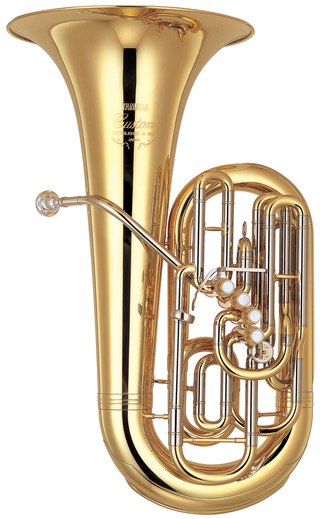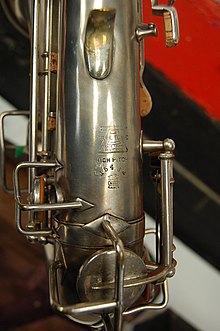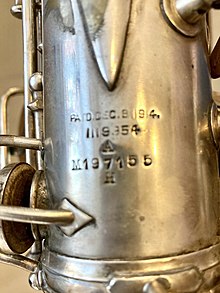
An equal temperament is a musical temperament or tuning system that approximates just intervals by dividing an octave into steps such that the ratio of the frequencies of any adjacent pair of notes is the same. This system yields pitch steps perceived as equal in size, due to the logarithmic changes in pitch frequency.

In music, there are two common meanings for tuning:
In music, notes are distinct and isolatable sounds that act as the most basic building blocks for nearly all of music. This discretization facilitates performance, comprehension, and analysis. Notes may be visually communicated by writing them in musical notation.

The trumpet is a brass instrument commonly used in classical and jazz ensembles. The trumpet group ranges from the piccolo trumpet—with the highest register in the brass family—to the bass trumpet, pitched one octave below the standard B♭ or C trumpet.

The tuba is the largest and lowest-pitched musical instrument in the brass family. As with all brass instruments, the sound is produced by lip vibration – a buzz – into a mouthpiece. It first appeared in the mid-19th century, making it one of the newer instruments in the modern orchestra and concert band, and largely replaced the ophicleide. Tuba is Latin for "trumpet".
In music, an octave or perfect octave is a series of eight notes occupying the interval between two notes, one having twice or half the frequency of vibration of the other. The octave relationship is a natural phenomenon that has been referred to as the "basic miracle of music", the use of which is "common in most musical systems". The interval between the first and second harmonics of the harmonic series is an octave. In Western music notation, notes separated by an octave have the same name and are of the same pitch class.

Pythagorean tuning is a system of musical tuning in which the frequency ratios of all intervals are based on the ratio 3:2. This ratio, also known as the "pure" perfect fifth, is chosen because it is one of the most consonant and easiest to tune by ear and because of importance attributed to the integer 3. As Novalis put it, "The musical proportions seem to me to be particularly correct natural proportions." Alternatively, it can be described as the tuning of the syntonic temperament in which the generator is the ratio 3:2, which is ≈ 702 cents wide.
C or Do is the first note of the C major scale, the third note of the A minor scale, and the fourth note of the Guidonian hand, commonly pitched around 261.63 Hz. The actual frequency has depended on historical pitch standards, and for transposing instruments a distinction is made between written and sounding or concert pitch. It has enharmonic equivalents of B♯ and D.

A transposing instrument is a musical instrument for which music notation is not written at concert pitch. For example, playing a written middle C on a transposing instrument produces a pitch other than middle C; that sounding pitch identifies the interval of transposition when describing the instrument. Playing a written C on clarinet or soprano saxophone produces a concert B♭, so these are referred to as B♭ instruments. Providing transposed music for these instruments is a convention of musical notation. The instruments do not transpose the music; rather, their music is written at a transposed pitch. Where chords are indicated for improvisation they are also written in the appropriate transposed form.

Pitch is a perceptual property of sounds that allows their ordering on a frequency-related scale, or more commonly, pitch is the quality that makes it possible to judge sounds as "higher" and "lower" in the sense associated with musical melodies. Pitch is a major auditory attribute of musical tones, along with duration, loudness, and timbre.
A440 (also known as Stuttgart pitch) is the musical pitch corresponding to an audio frequency of 440 Hz, which serves as a tuning standard for the musical note of A above middle C, or A4 in scientific pitch notation. It is standardized by the International Organization for Standardization as ISO 16. While other frequencies have been (and occasionally still are) used to tune the first A above middle C, A440 is now commonly used as a reference frequency to calibrate acoustic equipment and to tune pianos, violins, and other musical instruments.

Piano tuning is the act of adjusting the tension of the strings of an acoustic piano so that the musical intervals between strings are in tune. The meaning of the term 'in tune', in the context of piano tuning, is not simply a particular fixed set of pitches. Fine piano tuning requires an assessment of the vibration interaction among notes, which is different for every piano, thus in practice requiring slightly different pitches from any theoretical standard. Pianos are usually tuned to a modified version of the system called equal temperament.

Scientific pitch notation (SPN), also known as American standard pitch notation (ASPN) and international pitch notation (IPN), is a method of specifying musical pitch by combining a musical note name and a number identifying the pitch's octave.
This is a list of the fundamental frequencies in hertz (cycles per second) of the keys of a modern 88-key standard or 108-key extended piano in twelve-tone equal temperament, with the 49th key, the fifth A (called A4), tuned to 440 Hz (referred to as A440). Every octave is made of twelve steps called semitones. A jump from the lowest semitone to the highest semitone in one octave doubles the frequency (for example, the fifth A is 440 Hz and the sixth A is 880 Hz). The frequency of a pitch is derived by multiplying (ascending) or dividing (descending) the frequency of the previous pitch by the twelfth root of two (approximately 1.059463). For example, to get the frequency one semitone up from A4 (A♯4), multiply 440 Hz by the twelfth root of two. To go from A4 up two semitones (one whole tone) to B4, multiply 440 twice by the twelfth root of two (or once by the sixth root of two, approximately 1.122462). To go from A4 up three semitones to C5 (a minor third), multiply 440 Hz three times by the twelfth root of two (or once by the fourth root of two, approximately 1.189207). For other tuning schemes, refer to musical tuning.
A or La is the sixth note and the tenth semitone of the fixed-do solfège.
MIDI Tuning Standard (MTS) is a specification of precise musical pitch agreed to by the MIDI Manufacturers Association in the MIDI protocol. MTS allows for both a bulk tuning dump message, giving a tuning for each of 128 notes, and a tuning message for individual notes as they are played.
This article describes the process and techniques involved in the tuning of a pipe organ. Electronic organs typically do not require tuning.

Music theory analyzes the pitch, timing, and structure of music. It uses mathematics to study elements of music such as tempo, chord progression, form, and meter. The attempt to structure and communicate new ways of composing and hearing music has led to musical applications of set theory, abstract algebra and number theory.
B♭ (B-flat), or, in some European countries, B, is the eleventh step of the Western chromatic scale. It lies a diatonic semitone above A and a chromatic semitone below B, thus being enharmonic to A♯, even though in some musical tunings, B♭ will have a different sounding pitch than A♯. B-flat is also enharmonic to C.
Scientific pitch, also known as philosophical pitch, Sauveur pitch or Verdi tuning, is an absolute concert pitch standard which is based on middle C (C4) being set to 256 Hz rather than approximately 261.63 Hz, making it approximately 31.77 cents lower than the common A440 pitch standard. It was first proposed in 1713 by French physicist Joseph Sauveur, promoted briefly by Italian composer Giuseppe Verdi in the 19th century, then advocated by the Schiller Institute beginning in the 1980s with reference to the composer, but naming a pitch slightly lower than Verdi's preferred 432 Hz for A, and making controversial claims regarding the effects of this pitch.














